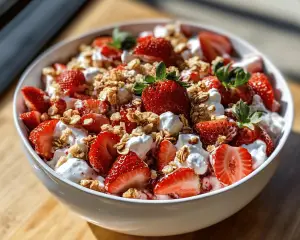The first time I made crepes, the kitchen was filled with a delicate mix of excitement and nervous energy. It was a Saturday morning, a glorious spring day when the sun streamed through the window, casting a warm glow across the table. I had invited my closest friends over for a brunch gathering, and there was something special stirring within me as I laid out my plans: the kind of plans woven with tenderness, nostalgia, and a hint of culinary adventure.
Crepes were always a thing of wonder for me — a stunning marriage of simplicity and elegance. I remember watching my grandmother skillfully flip them in her tiny kitchen, her laughter and chatter mixing with the sound of batter sizzling in a pan. She had a way of making it look effortless, her movements graceful as she poured just the right amount of batter, the creation of each one a tiny work of art. I recall teasing her about the tiny splatters of batter that always made their way to the stove: “How do you create more mess than a toddler in a paint store?” I had asked, laughter spilling out like the bubbles in her batter. Her answer was always the same, “Oh dear, that’s just a part of the process.”
It was the laughter, joy, and warmth that made crepes a hallmark in our family. They were not just about the delicate layers of flour and eggs; they were a symbol of togetherness. Today, as I stand in my own kitchen, with the light filtering through my curtains and the promise of good company just an hour away, I’m determined to recreate that magic.
My first attempt at making crepes as an adult was predictably chaotic. I had prepped everything: flour, eggs, milk, and a pinch of salt, all meticulously lined up like soldiers ready for battle. With confidence, I whisked them together, eager to pour the batter into the hot pan. But, as I flipped the first crepe, it transformed from a beautiful golden disc into an unfortunate mess stuck to the bottom. “Don’t panic,” I told myself, channeling my grandmother’s spirit. I scraped it off and laughed, a mix of frustration and joy bubbling up inside me.
Over the years, I’ve learned to respect crepes even more, to appreciate the beauty in their simplicity. They’re a blank canvas, waiting for your personal touch. You can dress them up in sweet or savory attire, and they still manage to carry within them the spirit of that first, messy attempt. I now make crepes with my children, who giggle and argue over who gets to pour the batter, who gets to flip, and who gets to taste test, of course. They’ve named our weekend tradition “Crepe Day,” and the laughter that ensues makes every bit of cleanup worth it.
Inside the Ingredients of the BEST Crepes
Let’s delve into the magic that makes crepes truly special. Each ingredient is a character in this culinary play, contributing to the overall story of flavor, texture, and emotion.
Flour:
This is the backbone of any crepe, providing structure and a soft texture. I typically use all-purpose flour, but I often ponder the possibilities of other varieties like whole wheat or almond flour. The key here is to sieve the flour to aerate it, to ensure a delicate batter that bakes up light and tender. Remember when you can feel the joy of dusting flour onto your workspace, it becomes less of a chore and more of an artistic expression.
Eggs:
Oh, the humble egg, packed with protein and richness that sets the foundation for our crepes. They add structure, but also a lusciousness that is hard to resist. My grandmother often insisted we crack the eggs one by one into a bowl first—“To catch a rogue shell,” she’d say, her eyes twinkling. It’s a great tip; trust me, catching a shell mid-crack can save you from a culinary disaster.
Milk:
Milk is essential for creating the right consistency. I prefer whole milk for its creaminess, but you can opt for almond milk or oat milk if you are looking for a dairy-free option. It contributes a certain silkiness we all crave, almost like a hug in liquid form. When you pour it into your batter and watch it meld with the flour and eggs, notice how it creates a dance of colors, a reminder of the beauty in blending.
Salt:
A pinch of salt is crucial for enhancing flavors. It may feel small, almost insignificant even, but it packs a mighty punch. Salt balances the sweetness in crepes and brings all the flavors together. My daughter insists on adding the “Magic Dust” as she calls it. Watch the seriousness on her face as she adds it, as if she’s casting a spell that will lift our crepes to new heights.
Butter:
Ah, sweet butter—the finishing touch. Melted and incorporated into the batter, it contributes richness and a slight nuttiness. Beyond enhancing flavor, butter makes the cooking process so much easier. When I ladle batter into the pan, it creates that delightful sizzle, revitalizing memories of my kitchen filled with warmth.
I also like to make sure I have extra butter on hand for greasing the pan between crepes. When you see that golden glow emerging from underneath, it’s impossible not to feel a rush of joy—it’s a celebration, one that’s well-deserved after all the effort that goes into creating something so simple yet profound.
How the BEST Crepes Fit Into a Balanced Life
In a world brimming with quick-fixes and fast food, crepes are a reminder of the beauty of mindful cooking. They embody the balance between nourishment and enjoyment—what a gift that is!
From a nutritional perspective, crepes can be surprisingly light. Depending on how you fill them and what you top them with, you can achieve a delightful balance of protein, carbs, and healthy fats. I find joy in filling them with fresh fruits or yogurt, creating a vibrant breakfast that feels indulgent yet wholesome. On the flip side, savory crepes filled with roasted vegetables, cheese, or even a smattering of smoked salmon can be comforting yet satisfying.
As I navigate the myriad diets and lifestyle choices of those I love, I cherish how versatile crepes can be. They fit into gluten-free, vegan, and many other dietary preferences with a few simple adjustments. You can use gluten-free flour or even chickpea flour to create a delicious alternative. My friend once suggested adding turmeric to the batter for its health benefits and vibrant color; the result was stunning and sparked inspiration for many future brunches.
But beyond nutrition and balance, crepes remind me of how to embrace joy without guilt. If I’ve had a long day, making crepes is my way of soothing my soul. The act of whisking, pouring, and flipping is meditative. I can find solace in the kitchen, embracing the imperfections alongside the victories.
This dish has taught me to celebrate the moments that matter: the laughter of my children, the camaraderie of friendship, and the beauty of sharing food at the table. Whether you’re making them for others or treating yourself, crepes occupy this space of love and connection. They remind us that food is much more than sustenance; it’s a vessel of memories, stories, and emotions.
What You’ll Need
– 1 cup all-purpose flour
– 2 large eggs
– 1 cup whole milk (or any milk of your choice)
– 1 tablespoon melted butter (plus extra for pan)
– 1/4 teaspoon salt
– (Optional) 1 tablespoon sugar, if using for sweet crepes
This recipe yields about 8-10 crepes, depending on how big you like to make them.
Preparing the BEST Crepes Step by Step
Here’s where the magic happens, my friend. Grab that mixing bowl, and let’s bring the ingredients together.
Start by whisking the flour and the salt in a large bowl. I often make a little well in the center and crack the eggs straight into it. Then, with my whisk, I carefully incorporate the flour from the edges, gradually mixing in the eggs as I go. Don’t be afraid to take your time; it’s a dance of patience.
Now, it’s time to add the milk. Just pour it in gently and continue whisking, ensuring there are no lumps. You want a smooth, thin batter. If things get a bit thick or lumpy, give it a journey in the blender — it’s a foolproof way to smooth things out.
Once you’ve achieved that silky consistency, add in your melted butter while the batter is still warm. It makes mixing in so much easier. After that, give it a breather. Let the batter rest for about 30 minutes if you can, although it’s not a hard rule. This little break allows the flour to absorb more liquid and work some magic.
When ready, heat a non-stick skillet over medium heat, allowing it to warm up. Lightly grease the pan with a little butter; use a paper towel to wipe away excess. You want it slippery but not saturated.
Now, here comes the flipping! Pour a small ladle of batter into the center of the skillet, then swiftly swirl it around — oh, the beauty of this motion! Listen for the sizzle; it’s a sign you’re doing it right. Let it cook for about 1-2 minutes until the edges lift and it turns golden. This is where the freedom lies; if it isn’t quite perfect, embrace it!
With a gentle toss of your wrist (or a spatula) flip that crepe. Let it cook for an additional minute on this side, then slide it out onto a plate. Repeat the process until you’ve cooked all your batter, layering the crepes with a piece of parchment paper to keep them from sticking together.
Before you know it, you’ll have a stack of delicate crepes—ready for filling and sharing, or perhaps enjoying solo with an indulgent drizzle of maple syrup.
Lessons from My Kitchen
As I reflect on my journey with crepes, I can’t help but laugh at the half-hearted attempts that turned into masterpieces, and the masterpieces that somehow morphed into humble pancake failures. I’ve learned that it’s okay not to get it right the first time. In those moments of chaos, laughter is often the best seasoning.
Variations? I’ve tried adding orange zest to the batter for a refreshing twist and even spooned in Nutella between crepes — a heavenly indulgence. Seasonal fillings also add a new dimension; why not jazz things up with fresh berries in the summer or spiced apples in fall?
I still cherish my grandmother’s advice: “It’s all about having fun.” She would tell me that cooking should always be without rigid rules. Every time I step into the kitchen, I remind myself of the balance of nurturing the dish while letting it evolve.
All these experiences, these delightful experiments, remind me that there is no perfect crepe. It’s not always about striving for perfection; it’s about enjoying the process, cherishing moments spent around the table, and embracing the smiles that come with it.
(Closing Thought)
As I reflect on the role these crepes play in my life, I find a sense of gratitude for the laughter, connection, and sheer joy that accompanies every flip. In each crepe lies a story—of kitchen adventures shared with family, of early mornings filled with hope, and afternoons stolen from routine.
Dear reader, may you take this recipe into your hands, let it become a part of your traditions, and a canvas for your creativity. Add your own unique ingredients, infuse them with nostalgia or create fresh memories, just as I have. In the end, it’s about more than a recipe; it’s about the joy of sharing and the love infusing each bite. What will your crepes reveal about your story?


